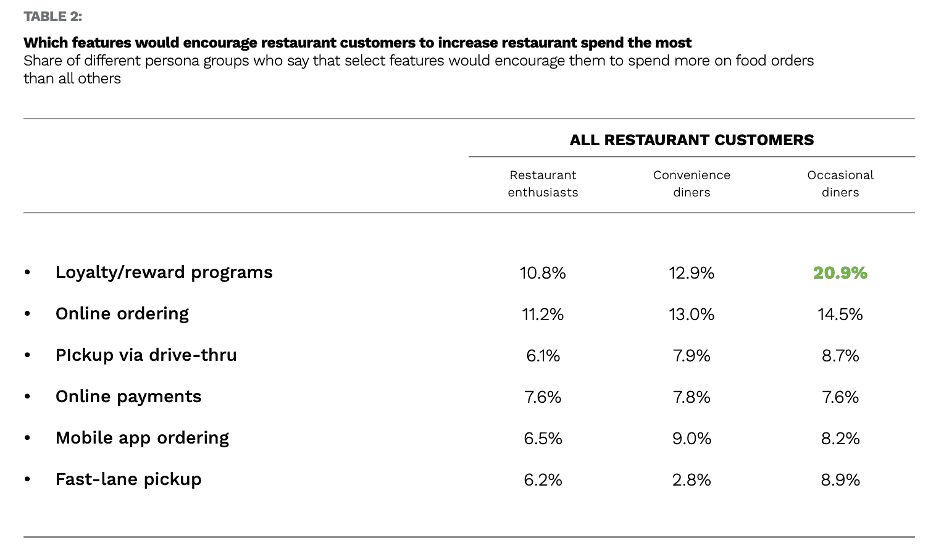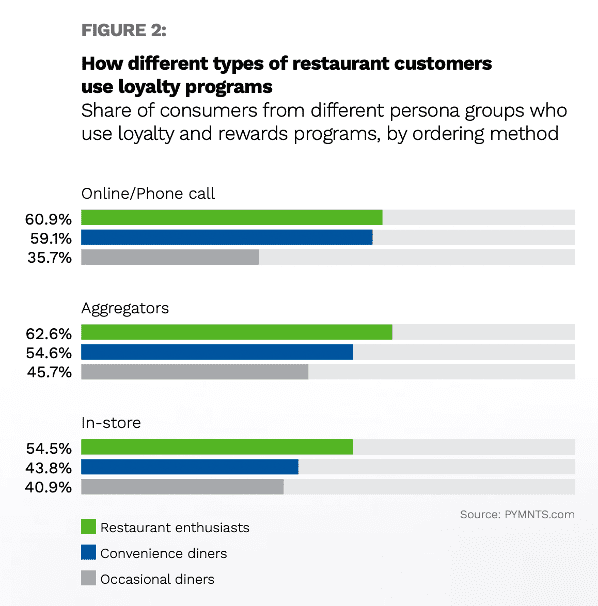
As most restaurant owners know, not all orders are created equal. A $30 order could be just that — a small, one-time profit — or it could be a jumping-off point for years of loyalty to come. In this month’s edition of PYMNTS’ Delivering on Restaurant Rewards report, created in collaboration with Paytronix, researchers found that restaurant enthusiasts — customers who order from sit-down restaurants or from both sit-down restaurants and QSRs twice a week or more — tend to be high-income consumers who will spend well above average on their orders. Thirty-eight percent of all restaurant customers who earn more than $100,000 per year are restaurant enthusiasts. Winning the loyalty of these enthusiasts and/or converting occasional customers into enthusiasts can have an enormous impact on profits.
One way to reach these customers is to improve remote ordering options. PYMNTS’ research shows that 26 percent of restaurant customers who order online or via phone are enthusiasts, as are 28 percent of restaurant customers who order using food aggregators. By contrast, enthusiasts make up only 16 percent of restaurant customers who order in person. To that end, many QSRs have been improving their delivery and pickup options: McDonald’s is piloting artificial intelligence (AI)-enabled drive-thru signage, Chipotle is testing out a car-side pickup program, and Burger King is trying out pickup lockers.
 Loyalty and rewards programs can turn occasional diners into restaurant enthusiasts. One in five occasional diners say they would be most likely to spend more on food orders if they had access to loyalty and rewards programs, and 53 percent of all occasional diners do not use loyalty and rewards programs simply because they don’t believe that such programs are available, and more than a fifth of these consumers say that offering loyalty and rewards programs is the biggest thing they can do to encourage them to spend more on food orders. Starbucks has seen enormous success in this area, with rewards customers comprising half of all U.S. company-operated sales. The program offers customers everything from drink customizations to free food/beverages to more durable merchandise like mugs and coffee accessories.
Loyalty and rewards programs can turn occasional diners into restaurant enthusiasts. One in five occasional diners say they would be most likely to spend more on food orders if they had access to loyalty and rewards programs, and 53 percent of all occasional diners do not use loyalty and rewards programs simply because they don’t believe that such programs are available, and more than a fifth of these consumers say that offering loyalty and rewards programs is the biggest thing they can do to encourage them to spend more on food orders. Starbucks has seen enormous success in this area, with rewards customers comprising half of all U.S. company-operated sales. The program offers customers everything from drink customizations to free food/beverages to more durable merchandise like mugs and coffee accessories.
Adopting Bridge Millennial-Friendly Technology
PYMNTS research found that bridge millennials, those ages 33 to 43, are the age group that spends the most on restaurant orders per month as well as the most per each order. These consumers exhibit behaviors of both millennials and Gen X consumers. They have grown up with access to computers and smartphones and are old enough to be professionally established and earn higher annual incomes than the average millennial. Their business will be key for any restaurant hoping to gain a foothold in the new, digital-first, takeout-centric food economy.
 PYMNTS’ previous research has found that bridge millennials tend to buy and use voice-assisted technologies long before other groups. Thirty-eight percent of bridge millennials own and use voice-activated devices, while 17 percent use those devices to make purchases. Restaurants that offer voice-activated ordering can tailor their offerings to this high-spending group.
PYMNTS’ previous research has found that bridge millennials tend to buy and use voice-assisted technologies long before other groups. Thirty-eight percent of bridge millennials own and use voice-activated devices, while 17 percent use those devices to make purchases. Restaurants that offer voice-activated ordering can tailor their offerings to this high-spending group.
As PYMNTS and Kount researchers highlighted in the November Mobile Order-Ahead report, card network Mastercard and California-based AI and speech recognition company SoundHound have partnered to establish a voice-based, drive-thru solution for quick-service restaurants (QSRs). The companies said the service aims to transform these interactions by using voice ordering and AI, offering drive-thru customers seamless experiences and faster-moving lines. The voice and AI technology allows the ordering system to quickly and accurately analyze and process complicated orders that might include substitutions or special requests.
Investing in the Highest-Grossing Models
Consumers are spending much more per month on off-premises dining than on dine-in, with the average customer spending $201 per month on table-service restaurant online orders versus just $127 on dine-in. Though average spending per ticket is higher for the latter than the former, online ordering proves to be a more reliable source of profits. Additionally, off-premises orders bring in more restaurant enthusiasts and contribute to more rewards program usage, building customer loyalty.
Consequently, restaurants that invest more in building up their takeout and delivery service than on improving their in-store offerings are likely to see a higher return on investment. In that vein, delivery-only ghost kitchens have boomed in the past year. Hot dog QSR chain Nathan’s Famous has 100+ such locations as of this month. In November, QSR giants Chipotle and Red Lobster both unveiled ghost kitchens, while chains such as McDonald’s and Starbucks have been piloting digital-only kitchens since pre-pandemic. By developing these online-centric locations, restaurants can expand their audiences without making costly real estate investments or hiring hospitality workers and wait staff.
 Using Social Media Marketing to Reach High-Spending Consumers
Using Social Media Marketing to Reach High-Spending Consumers
Consumers of certain income levels also order food more often than others, with those in the highest income bracket ordering more than the rest. Accordingly, targeting high-income consumers in spaces they frequent can bring in loyal, high-spending consumers.
One such space is social media. Khoros’ analysis found that 60 percent of households with an annual income above $100,000 use Instagram, compared to 44 percent with an income under $30,000. Twitter, meanwhile, commands about twice as large a share of $100,000+ households as of $30,000, as does LinkedIn.
In the last year, Burger King has leveraged clever social media promotions to attract and retain these consumers. For example, the chain has been responding directly to tweets from dissatisfied McDonald’s customers, using offers of free whoppers to convert them into satisfied BK customers. The chain also used a clever and highly shareable Venmo campaign to generate attention among digitally-savvy consumers.
All restaurants serve a diverse array of customers, but bridge millennials, millennials and Generation Z customers not only order the most frequently, but are also most likely to use digital purchasing channels. Targeting these customers through both marketing and loyalty offerings can increase spend — even among the most occasional diners. This type of holistic, multichannel approach can go a long way toward helping restaurants achieve their best performance.